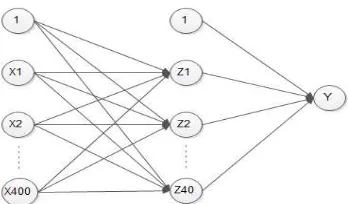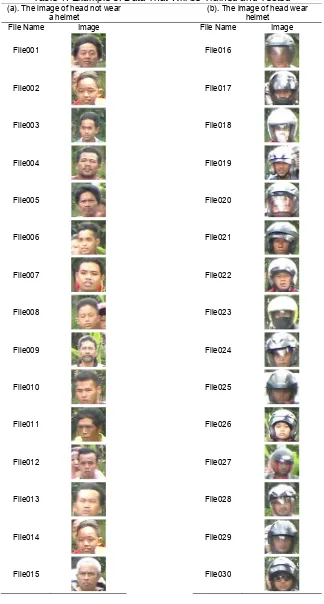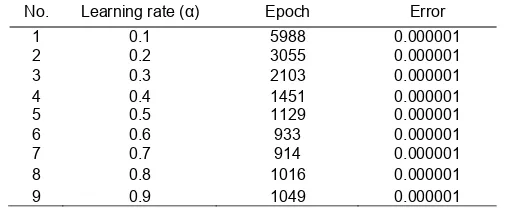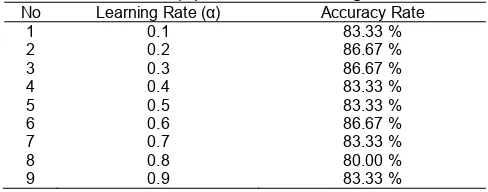DOI: 10.12928/TELKOMNIKA.v14i3.3486 1128
Classification of Motorcyclists not Wear Helmet on
Digital Image with Backpropagation Neural Network
Sutikno*, Indra Waspada, Nurdin Bahtiar, Priyo Sidik Sasongko Department of Computer Science/Informatics, Faculty of Science and Mathematics,
University of Diponegoro
Prof. Soedarto Street, Tembalang, Semarang 50275, Indonesia *Corresponding author, e-mail: [email protected]
Abstract
One of the world’s leading causes of death is traffic accidents. Data from World Health Organization (WHO) that there are 1.25 million people in the world die each year. Meanwhile, based on data obtained from Statistics Indonesia, traffic accidents from 2006 to 2013 continue to increase. Of all these accidents, the largest accident occurred at motorcyclists, especially motorcyclists who not wearing standard helmet. In controlling the motorcyclists, police view directly at the highway, so that there are weaknesses which there are still a possibility of motorcyclist offenders who are undetectable especially for motorcyclists who are not wear helmet. This paper explains research on image classification of human head wearing a helmet and not wearing a helmet with backpropagation neural network algorithm. The test results of this analysis is the application can performs classification with 86.67% accuracy rate. This research can be developed into a larger system and integrated that can be used to detect motorcyclists who are not wearing helmet.
Keywords: traffic accidents, classification, not wearing a helmet, backpropagation neural network
Copyright © 2016 Universitas Ahmad Dahlan. All rights reserved.
1. Introduction
Traffic accidents are one cause of death in the world. Data obtained from World Health Organization (WHO), the number of people who died in the world caused by traffic accidents totaled 1.25 million people annually [1]. While in Indonesia, based on data from Statistics Indonesia, number of accidents recorded from 2006 to 2013 continues to increase. Of all these accidents, the biggest accident occurred on motorcyclists [2]. One of the reasons that the motorcyclist were not wearing a helmet according to standards set by the government.
The government has issued regulation No. 22 of 2009 on traffic and road transportation which one of the purpose is to decrease the death rate that caused by traffic accident. One of the contents in the regulation that is in article 106 paragraph 7 states that every person driving a motorcycle and the motorcycle passenger must wear a helmet that meets national standards of Indonesia [3].
Meanwhile, all this time, supervision of motorcyclists on the road by the police is still done manually by looking directly at the highway. There are weaknesses which there is still a possibility of motorcyclist off enders who are undetectable, especially for motorcyclists who were not wearing helmets, still if the police is standing guard at the police station, they can not know motorcyclists who were not wearing helmets. One solution to overcome that problem is to utilize the camera in conducting surveillance on highways and combined with the detection process for detecting the presence of motorcyclists who were not wearing helmets.
There are several researches that have been done relating to the monitoring of the traffic that is using a camera with good results [4-6]. On those researches, the camera was only used for monitoring and image from the result of recording was not used well. The result of the recording can be used for example to detect or to classify motorcyclist wearing a helmet or not automatically. Research from this classification issues has been done by using Support Vector Machines (SVM) to generate an accuracy rate of 85% [7].
identification of varieties of food, stone texture identification, shape identification, moldy peanut kernels identification, identification of external quality of wheat grain, dermatological diseases detection, and renal tumor detection [8-18]. The results of this research may contribute to the development of violation detection systems, of motorcyclists not wearing a helmet, automatically based on digital image that captured by the camera.
2. Research Method 2.1. System Description
Description of application that undertaken in this research can be seen in Figure 1.
Figure 1. Description of Application
Figure 2. Architecture of Backpropagation Neural Network
In the outline, the system that was built is divided into two parts, namely training process and testing process.
a. The training process
The training process begins by entering some data in the form of motorcyclist image that wear helmet and not wear helmet. After that, the data is carried out a process of image processing so the result is image feature. Further, feature image is stored in the data base. Feature image that has been stored was trained using backpropagation neural network. The results of this training are in the form of weighted values of backpropagation neural network architecture.
b. The testing process
this process are used to test whether the image is an image of the head of a motorcyclist wearing a helmet or not.
Table 1. Example of Data That Will be Trained and Tested (a). The image of head not wear
a helmet
(b). The image of head wear helmet
File Name Image File Name Image
File001 File016
File002 File017
File003 File018
File004 File019
File005 File020
File006 File021
File007 File022
File008 File023
File009 File024
File010 File025
File011 File026
File012 File027
File013 File028
File014 File029
2.1. Architecture of Backpropagation Neural Network
Backpropagation neural network architecture of this system consists of 400 inputs, one hidden layer consists of 40 neurons, and one output as in Figure 2.
3. Results and Discussion
This research conducted two tests, namely backpropagation neural network training and performance of backpropagation neural network algorithm.
3.1. The Testing of Backpropagation Neural Networks Training
The data that used as training amounted to 150 images which consists of 75 images of the head wearing a helmet and 75 images of the head not wearing a helmet. The image size that used as training is 20x20 pixel, the example is in the Table 1. The purpose of this training is to find the best suitable network patterns of the architecture that has been created which produces values of network weights.
Testing of network training is using training interface as in Figure 3 with same input limit of epoch and error which maximum limit of epoch is 30.000 and boundary error is 0.000001. This test will find the influence of variations in rate of learning (α) between 0.1 up to 0.9, then searched the lowest epoch. These test results are shown in Table 2.
Figure 3. Training Interface of Backpropagation Neural Network
Table 2. Testing Training Result of Backpropagation Network with A Learning Rate (α) Variation No. Learning rate (α) Epoch Error
1 0.1 5988 0.000001
2 0.2 3055 0.000001
3 0.3 2103 0.000001
4 0.4 1451 0.000001
5 0.5 1129 0.000001
6 0.6 933 0.000001
7 0.7 914 0.000001
8 0.8 1016 0.000001
9 0.9 1049 0.000001
3.2. Testing Performance Backpropagation Neural Network Algorithm
This test is used to measure performance of back propagation neural network algorithm in classifying the image of a human head wearing helmets and not wearing a helmet. The interface used in these tests as in Figure 4. This test is using data from the network weights training result variation of learning rate. Input from these tests are 30 images with a size of 20 x 20 pixels composed of 2 types of 15 images of human heads were not wearing helmets and 15 images of man wearing a helmet as shown in Table 1. The testing results performance of the backpropagation neural network algorithm which using the data of network weights with each administration of learning rate values are as shown in Table 3.
Figure 4. Testing Interface from Performance of Backpropagation Neural Network Algorithm
Table 3. Testing Performance Results of Neural Network Algorithm with a Variation of Learning Rate (α) Value on Training
No Learning Rate (α) Accuracy Rate
1 0.1 83.33 %
2 0.2 86.67 %
3 0.3 86.67 %
4 0.4 83.33 %
5 0.5 83.33 %
6 0.6 86.67 %
7 0.7 83.33 %
8 0.8 80.00 %
9 0.9 83.33 %
From Table 2 shows that the best accuracy is obtained on the results of training with a learning rate value of 0.2, 0.3, and 0.6 in the amount of 86.67%. Whereas the method of Support Vector Machines (SVM) was used for the same case with the average accuracy rate is 85% [7]. This accuracy level can be improved by increasing the number of training data because the performance of backpropagation neural network algorithm is affected by the amount of data variation that has been trained.
4. Conclusion
References
[1] World Health Organization. Global Status Report on Road Safety 2015. World Health Organization (WHO). 2016.
[2] Statistics Indonesia. Land Transportation Statistics 2014. Statistics Indonesia. 2015.
[3] Yudhoyono SB. Regulation of the republic of indonesia No 2/2009 about traffic and road transportation. Jakarta. 2009.
[4] Collinson PA. The application of camera based traffic monitoring systems. CCTV and Road Surveillance, IEE Seminar on. London. 2009: 81-86.
[5] Parkyns DJ, Bozzo M. CCTV Camera Sharing for Improved Traffic Monitoring. Road Transport Information and Control-RTIC 2008 and ITS United Kingdom Members' Conference, IET. Manchester. 2008: 1-6.
[6] Shi H. Design of a Distributed Traffic Monitoring System and Algorithm Based on Web-Camera. Information Processing (ISIP), 2008 International Symposiums on. Moscow. 2008: 758-761.
[7] Chiverton J. Helmet presence classification with motorcycle detection and tracking. IET Intelligent Transport Systems. 2012; 6(3): 259-269.
[8] Azizi A, Abbaspour-Gilandeh Y, Nooshyar M, Afkari-Sayah A. Identifying Potato Varieties Using Machine Vision and Artificial Neural Networks. International Journal of Food Properties. 2016; 19(3): 618-635.
[9] Cheng GJ, Ma W, Wei XS, Rong CL, Nan JX. Research of rock texture identification based on image processing and neural network. Xi'an Shiyou Daxue Xuebao (Ziran Kexue Ban)/Journal of Xi'an Shiyou University, Natural Sciences Edition. 2013; 28(5): 105-110.
[10] Rajini GK, Reddy GR. Performance evaluation of neural networks for shape identification in image processing. International Conference on Signal Acquisition and Processing (ICSAP). Bangalore. 2010: 225-258.
[11] Chen H, Xiong L, Hu X, Wang Q, Wu M. Identification method for moldy peanut kernels based on neural network and image processing. Nongye Gongcheng Xuebao/Transactions of the Chinese Society of Agricultural Engineering. 2007; 23(4): 158-161.
[12] Wang Z, Cong P, Zhou J, Zhu Z. Method for identification of external quality of wheat grain based on image processing and artificial neural network. Nongye Gongcheng Xuebao/Transactions of the Chinese Society of Agricultural Engineering. 2007; 23(1): 158-161.
[13] Yasir R, Rahman MA, Ahmed N. Dermatological disease detection using image processing and artificial neural network. 8th International Conference on Electrical and Computer Engineering: Advancing Technology for a Better Tomorrow, ICECE. Pan Pacific Sonarga on Dhaka. 2014: 687-690.
[14] Ghalib MR, Bhatnagar S, Jayapoorani S, Pande U. Artificial neural network based detection of renal tumors using CT scan image processing. International Journal of Engineering and Technology. 2014; 6(1): 28-35.
[15] Hartati S, Harjoko A, Supardi TW. The Digital Microscope and Its Image Processing Utility. TELKOMNIKA Telecommunication Computing Electronics and Control. 2011; 9(3): 565-574.
[16] Permana TP, Abdurohman M, Khairudin M, Lutfi M. Automated Navigation System based on Weapon-Target Assignment. TELKOMNIKA Telecommunication Computing Electronics and Control. 2011; 9(3): 445-452.
[17] Aldasouqi I, HassanM. Smart Human Face Detection System. International Journal of Computers. 2011; 5(2): 2010-2017.



